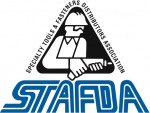STAFDA 2011 Session Preview: The Rise of the Green Regs
Whether you are dragged kicking and screaming, pushed, or led to green building, it doesn’t matter: The regulations are here. But here’s how STAFDA members can profit.
 |
 |
There Attend any trade show or flip through any trade magazines, and you will see that the green building movement is still in full bloom. In fact, during the construction downturn, green building is the only aspect of construction that continued to grow.
Until the last two years or so, your participation in the green building movement was entirely voluntary, either as a manufacturer/marketer of green products or in your role helping contractors achieve green results.
Until recently, there were very few product labeling laws, and the whole-house/whole-structure green rating systems (e.g. ENERGY STAR, NAHB, and LEED) were published almost as a public service for those who had the desire and cash to go green.
Well, that’s all changed now.
For starters, the Federal Trade Commission has finally stepped in. The International Green Construction Code (IgCC) will soon be requiring green practices, backed by the force of law (e.g. enforced by building inspectors checking for compliance). Ironically, some of the green rating standards created to discourage government regulation (e.g. the NAHB’s National Green Building Standard) ended up getting adopted – wholly or in part – as requirements for contractors.
With all that said, I run into contractors who keep asking me when the green thing is going to fade, so they can go back to building the way it used to be. Well, if you are asking that same question, don’t hold your breath.
The green building movement is here to stay. Its regulations are increasingly getting folded into standards and required building practices, and this is a trend that will only increase, however incrementally, for years to come. In fact, the term “green building” will likely fade some day, and we’ll just go back to calling it building even though it really is green building.
Impact on Distributors
What’s this mean for STAFDA members? Many of the items that STAFDA members sell help a contractor achieve points by building more-efficient structures in a more-efficient manner. That said, new Federal Trade Commission (FTC) laws may impact what you can say about your products, whether they are tools or fasteners, or products offered by allied lumber-and-building-material locations.
Sure, a few years ago, it was the Wild West in terms of product labeling. Labeling practices were essentially unregulated (except by consumer class-action suits), and you could say just about anything about your products: “Go Green With Pneumatic Nail Guns!”
With all the wild claims that were being made, you really can’t blame the Feds for intervening here … for example, SC Johnson made a big marketing push around Windex and Shout being “Greenlist” products (kind of / sort of implying that Greenlist was a third-party certifier), when in fact the certification was created by none other than …
SC Johnson.
That effort may have temporarily won them a few concerned-mom buyers, but it also got them a costly class-action lawsuit (settled in July 2011 with discontinuation of the label system). You may detect the same manipulation of consumers with such labeling claims as “powered by nature,” “inspired by nature,” or “eco-friendly.” The labels are everywhere; Ecolabel Index says there are almost 90 in North America alone.
But now, because of new FTC action, any manufacturer/marketer that makes an environmental claim faces tighter rules, because the FTC has revised its “Green Guides,” which were created 12 years ago (light years by green standards). Now, marketers have to qualify their claims on the product packaging and limit the claim(s) to specific benefit(s).
The new FTC rules also demand that companies disclose if their green certifications are from true third-parties, or were created in-house. If a trade association certifies a product, and the company is a member of the trade association, that too must be disclosed to the consumer.
Claims of “renewable” have to be specific about material sources. Also, now a new set of rules governs claims of “nontoxic” or “free of.” And a manufacturer cannot claim a process uses “renewable energy” if any part of the product was derived from fossil fuels.
Wow, strict!
Are the new labeling laws welcome? I wish they had come from industry sources, if only because industry sources can react faster and better to the market, as we have seen with wood standards. Candidly, the reluctance by the FTC to step in did not do the green building movement any favors. All it did was introduce doubt and cynicism among buyers.
On the other hand, the inability of manufacturers to collaborate with an honest, long-term strategy has only cost them all more money, and turned off some of the consumers who would otherwise have been their biggest advocates.
Rise of Green Regs
Just to underscore the rate of adoption of green regs, here are some stats from an American Institute of Architects (AIA) report, called Local Leaders in Sustainability (http://www.aia.org/aiaucmp/groups/aia/documents/document/aiab081614.pdf). There is no doubt that green building products and practices are now being required in building codes at local and regional levels. (This report was published 18 months ago, but the trend has only accelerated.) The local adoption of these codes and regs is nothing short of an upsurge, and that’s to say nothing of how green building standards like USGBC’s LEED and the National Green Building Standard (from NAHB) are being adopted.
The Local Leaders in Sustainability has found that:
- There are 138 cities with green building programs, or more than 1 in 5 cities surveyed. This is a 50 percent increase in green building programs since 2007;
- More than 53 million Americans live in cities with green building programs; and
- 24 of the 25 most-populated metropolitan regions in the U.S. are built around cities with green building policies.
- More than 20% of U.S. cities with more than 50,000 residents have green building regulation and policies in place. (When you look across all the cities surveyed for the study, more than 20 percent have green building programs.)
If you live out west, there are 56 green building programs in just six states. The eastern region now claims 49 cities with green policies in place, a rise of 75 percent over 2007 numbers. A remarkable trend.
If that’s not enough to convince you, look at the work that’s been done by the NAHB, whose National Green Building Standard was approved by the American National Standards Institute (ANSI). The National Green Building Standard was a collaborative effort between the International Code Council (ICC) and NAHB.
The Standard provides “green” practices that can be incorporated into new homes, but it’s not limited to residential, which many people thought was NAHB’s sole intent. The National Green Building Standard can be used for high-rise multifamily buildings, home remodeling and additions, and even hotels and motels.
NAHB is certainly giving LEED a run for its money in the residential sector, by presenting a decidedly pro-builder/pro-contractor green-building standard to compete with LEED-H, and they might even pick up some business in the commercial spaces, where LEED had achieved clear dominance.
How Can STAFDA Members Help?
STAFDA members are likely not selling products that directly account for many of the points in the national whole-house and whole-building rating systems, such as low-VOC paints or certified wood products.
But STAFDA members should keep a key point in mind about green building: A great many of the points needed to achieve approval by the whole-house and whole-building rating systems come from thermal envelope integrity, and that integrity is achieved through old-school structural integrity, obtained through the direct use of STAFDA member’s products and tools.
For instance, there are insulation requirements and baseline air-infiltration performance requirements that contribute to these green points, but when you really dig into the standards, as I have, you see that green building is not that exotic after all. Certainly, green building requires the use of greener versions of traditional building products, but the products still have to be installed, framed, and fastened using best-practices and top-quality products, if the contractor is to avoid call-backs and the risk of being docked points for a building that isn’t well-made.
That’s the role STAFDA members can play, by provisioning contractors with the tools and fasteners they need to build to increasingly demanding standards and tighter tolerances — and at greater speed. CS
The award-winning author of 12 books and a frequent contributor to the industry’s leading trade magazines, John D. Wagner is a sought-after speaker on green building, construction, woodcrafts, home building, the supply chain and corporate management. Contact him via his Web site at www.johndwagner.com.
















